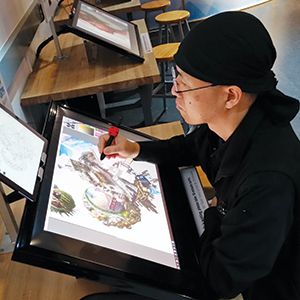

In the new exhibit Reboot Reality, The Tech Museum of Innovation harmonizes the polarities of material excess and homelessness. Located upstairs on the second level, the showcase partners with Silicon Valley heavyweights Adobe, HP, Stanford and Google on several different projects involving VR, augmented reality or mixed reality.
The headlining experience comes in the form of Birdly, a one-of-a-kind VR flight simulator allowing users to fly through the skyline of Manhattan. It’s not just a headset. The user straps into a birdlike set of wings and flaps his or her arms in various maneuvers, all to soar through the New York City skyline.
Birdly looks impressive, but I didn’t want to visit Manhattan. Instead, I wanted to yell at my landlord, live in my car, and then ride the bus with homeless people. All of which I could do at another VR project, one produced by researchers from Stanford’s Virtual Human Interaction Lab. Generally speaking, the lab encourages visitors to explore how VR affects the way we feel about ourselves, each other or the environment. In other words, they research VR’s role in the development of empathy.
The Stanford project allows the user to experience what it’s like to lose your apartment and be forced to live on all-night public transportation vehicles. The adventure opens up with the landlord banging on the door and screaming for the rent money while the user sits inside his place, pointing the VR controllers at certain items in the apartment, deciding which ones to pawn first. But after selling most everything, he still doesn’t have enough. As a result, he winds up living in his car. After the user sells his car, the next scene puts him on the bus with nothing but a backpack to his name, all while trying to avoid a shady character harassing those on the bus who are homeless. The scene is obviously modeled after VTA route 22, which only gets more depressing as every year goes by.
On the bus, the user then points the VR controllers at each homeless person to hear that person’s story, the background of how he or she became homeless, and what it feels like. The point of it all is to ascertain VR’s usefulness—as opposed to other media—at increasing empathy. Folks from the Stanford lab, including staffer Elise Ogle, were on hand to explain their success in doing just that.
For me, this was not so “virtual” in that I often already ride on the same buses with homeless people. And don’t even get me started on the rent scenarios around here. But the VR experience absolutely increased my empathy and decreased my apathy. Being an inward-looking dude to begin with, it was nice to contemplate the issue without being surrounded by a zillion people arguing about it.
Don’t get me wrong: plenty of happy stuff exists in Reboot Reality. Adobe’s newish project, Wetbrush, for example, was on display in full force. Using ultra-high-end NVIDIA hardware and a super-hi-tech stylus, people can now paint in 3D on a screen, imitating many of the techniques and parameters in analog oil painting. One can implement brush techniques, pushing harder or softer with the stylus to fan the brush out. The user can create layers, textures, and engage with other processes from real painting. After which a 3D-printed version can be created, one that looks similar to a real oil painting. Daichi Ito, a technical artist from Adobe’s Imagination Lab, was on hand to demonstrate the product. He was previously an animation student at SJSU.
Other projects in the show include “Sprout” by Hewlett-Packard, allowing users to scan physical objects and mix them into Snapchat filters. “Medium” by Oculus allows users to enter a VR world and create their own sculptures out of clay.
None of the projects involve consumer technology that we’ll see in our homes, or on the bus, any time soon. But that’s the point. The Tech now has an experimental space where Silicon Valley companies can beta-test their VR projects on the general public. So if you want to berate your landlord, go to The Tech instead. You might learn something and acquire empathy in the process.



